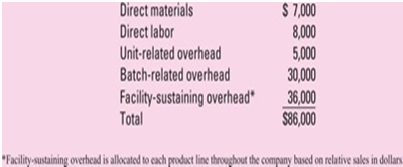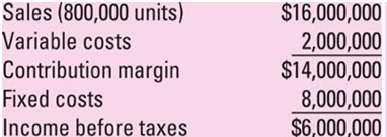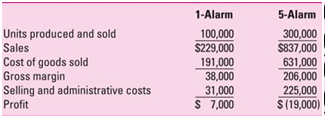Quantity (EOQ)
Complete the following problems:
- E4-5
- P4-8
- P4-10
- P5-4
- P5-9
E4
- Meeker Company is developing a new product. The selling price has not yet been determined, nor are the variable costs per unit known. The fixed costs are $600,000. Management plans to set the selling price so that variable cost is 55 percent of the selling price.
- A. What is the contribution margin ratio?
- B. What is the breakeven point in dollars?
- C. If management desires a profit of $50,000, what will total sales be?
E5
- Crow, Inc., a not-for-profit company, has a product contribution margin of $40. The fixed costs are $800,000. Crow, Inc., has set a target profit of $35,000 per year.
-
- A. What is the breakeven point in units?
- B. How many units must be sold to achieve the target profit?
- C. If fixed costs decrease 10 percent, how many units must be sold to achieve the target profit?
P4.4
Burt Company makes a product that includes a component part, Item XJ7. Presently, the company purchases XJ7 from an outside supplier for $48 each. Burt Company is considering manufacturing XJ7 itself. Estimated total manufacturing costs for the yearly requirement of 1,000 units of XJ7 follow. Burt anticipates producing XJ7 in 5 batches.

Required:
-
- A. Should Burt Company make or buy component XJ7?
- B. If the company could reduce the number of batches needed from 5 to 2, would your answer change? Why or why not?
- C. Discuss the additional factors Burt should consider before making this decision.
P4.5
- Dirt Devils is a partnership that specializes in office cleaning. The charge per office averages $175 per visit. The variable costs per visit are $65. The fixed operating costs are $90,000. The management of Dirt Devils wants to maintain a profit of 10 percent of total sales revenue. (Hint: Define the desired profit as a percentage of sales rather than a dollar amount.)
Required:
-
- A. What is the profit equation?
- B. How many offices must be cleaned to achieve the profit goal?
- C. If the price charged for office cleaning is increased by 20 percent, how many offices must be cleaned to achieve the profit goal?
- D. What are the problems that might be encountered by changing the price charged for office cleaning? Why?
P4.6
- Aberra Corporation sells widgets for $15 each. For the month of June, Aberra sold 8,000 widgets and reported variable costs of $24,000 and fixed costs of $78,000. Assume that Aberra increased its selling price by 20 percent on July 1.
-
- A. How many widgets have to be sold in July to break even?
- B. How many widgets have to be sold to earn a before-tax profit of $44,000?
- C. If Aberra is subject to an income tax rate of 30 percent, how many widgets have to be sold to earn an after-tax profit of $44,000?
- D. How many widgets have to be sold to earn a before-tax profit of 20 percent of sales? (Hint: Define the desired profit as a percentage of sales rather than a dollar amount.
- E. How many widgets have to be sold to earn an after-tax profit of 20 percent of sales?
P4.7
- Be Thin is a weight control center in Dallas. Clients are charged a fee of $800 for the weight control, counseling, and maintenance program. The average client spends 15 weeks in the program. In addition, each client must purchase a weekly food allowance at the center during the 15-week program. The average cost per client per week for food is $75. The variable costs per client per program average $80. This includes the cost of initial paperwork, insurance, and administrative costs. The variable costs per client per week average $20. This includes the cost of food, utilities, and counselors' salaries. The fixed costs of operations including rent, property insurance, and other fixed administrative costs amount to $9,000 per 15-week period.
Required: Assume independent situations.
-
- A. How many clients must Be Thin have each 15-week period to break even?
- B. If Be Thin desires a before-tax profit of $8,000 per 15-week period, how many clients are needed?
- C. If Be Thin has 50 clients each 15-week period, what is the profit before taxes?
- D. If the program fee per client is increased by 15 percent, how many clients are needed to break even each 15-week period?
- E. If the program fee per client is increased by 15 percent and the number of clients per 15-week period falls to 40, what is the profit before taxes each 15-week period? Should the program fee be increased? Explain.
- F. If the variable costs per client per week are decreased by $2, how many clients are needed each 15-week period to break even?
- G. If the variable costs per client per week are decreased as in part (F) and Be Thin has 55 clients each 15-week period, what is the before-tax profit each 15-week period?
P4.8
- Buchanan Enterprises has projected its income before taxes as follows:

Required:
-
- A. What is the selling price per unit?
- B. What is the variable cost per unit?
- C. What is the contribution margin per unit?
- D. What is the contribution margin ratio?
- E. What is the breakeven point in units?
- F. What is the breakeven point in dollars?
P4.9
Quinton Corporation produces and sells two types of chili: 1-Alarm and 5-Alarm. Operating performance for the most recent quarter is:

Management is puzzled by these results because they spent $120,000 on advertising 5-Alarm Chili last quarter (included in selling and administrative costs) and increased sales by 50,000 jars. The accountant investigated the cost structure and discovered the following about the 5-Alarm Chili.
-
- Cost of goods sold consists of unit-related, batch-related, product-sustaining, and allocated facility-sustaining costs. Unit-related costs are $0.75 per jar, batch-related costs are $800 per batch (batch size is 2,500 jars), and ongoing research and development costs are $10,000 per quarter. Facility-sustaining costs of $400,000 per quarter are allocated to the product lines based on the number of units produced.
- Selling and administrative costs consist of unit-related, product-sustaining, and facility-sustaining costs. Unit-related costs are $0.15 per jar. Advertising is the only product-sustaining cost and facility-sustaining costs of $80,000 per quarter are allocated to the product lines based on the number of units sold.
Required:
-
- A. Should the 5-Alarm Chili line be discontinued? Why?
- B. What other factors should Quinton consider before making this decision?
P4.10
Crawford sells three types of games to national toy companies. These games are known internally as Gamma, Omega, and Lambda. Recently the Gamma and Lambda lines have not shown acceptable profits. The most recent monthly results are:

Additional analysis reveals that $150 per month in facility-sustaining selling and administrative cost is charged to each product line. The remaining costs are assumed to vary directly with the number of units sold. Crawford is analyzing the following alternatives:
-
- 1. Discontinue the Gamma line and increase advertising at a cost of $10 per month for the Lambda line. This is expected to increase Lambda sales by 20 percent.
- 2. Discontinue the Gamma and Lambda lines and focus solely on the Omega line. This is expected to increase Omega sales by 40 percent.
- 3. Increase promotion of both the Gamma and Lambda lines. The promotion will increase selling costs by $25 per month for each line. Unit sales of Gamma are expected to increase by 15 percent while unit sales of Lambda are expected to increase by 10 percent.
- 4. Do nothing. Leave the Gamma, Lambda, and Omega lines as they are.
Required:
-
- A. Evaluate each alternative. Which alternative is best for Crawford Company?
- B. What additional factors should Crawford consider before making this decision?
P5.1
Refer to Walt Disney Company (www.disney.com). Based on your knowledge of this company, answer the following questions:
-
- A. Describe its customers, competitors, and legal/social environment.
- B. Do you believe this company sets its selling prices based primarily on market factors or primarily on cost? Why?
- C. Describe Disney's short-term and long-term carrying costs and ordering costs.
- D. Describe its suppliers.
- E. What inventory method do you believe Disney uses? Why?
- F. What type of compensation package do you think it provides for its employees? Why?
- G. What does the annual report tell you about executive compensation?
- P5.2
Refer to PepsiCo (www.pepsico.com). Based on your knowledge of this company, answer the following questions:
-
- A. Describe its customers, competitors, and legal/social environment.
- B. Do you believe Pepsi sets its selling prices based primarily on market factors or primarily on cost? Why?
- C. Describe its short-term and long-term carrying costs and ordering costs.
- D. Describe its suppliers.
- E. What inventory method do you believe it uses? Why?
- F. What type of compensation package do you think Pepsi provides for its employees? Why?
- G. What does the annual report tell you about executive compensation?
- P5.3
Refer to Dell Computer (www.dell.com). Based on your knowledge of this company, answer the following questions:
-
- A. Describe its customers, competitors, and legal/social environment.
- B. Do you believe Dell sets its selling prices based primarily on market factors or primarily on cost? Why?
- C. Describe Dell's short-term and long-term carrying costs and ordering costs.
- D. Describe its suppliers.
- E. What inventory method do you believe it uses? Why?
- F. What type of compensation package do you think Dell provides for its employees? Why?
- G. What does the annual report tell you about executive compensation?
- P5.4
Bunkowske Company plans to introduce a new product next year. This product has a two-year life and an estimated demand of 20,000 units annually. The product will be produced 50 weeks each year. Bunkowske estimates the following costs:
-
- •Direct materials will be $16 per unit.
- •Setup costs will be $200 per week. Ten setups will be required per week.
- •Design costs will be $40,000 in total.
- •Specialized equipment must be rented for $15,000 per week.
- •Research and development costs are estimated at $500,000.
- •Labor will be paid $20 per hour. Five employees will be assigned to this product and each employee will work 35 hours on the product.
Bunkowske Company uses cost-plus pricing whereby the selling price of each of its products are 150 percent of the life-cycle costs. Determine the selling price of this product.
P5.5
Rossetter, Inc., has 10 employees. Jan and Fred are each paid a salary of $4,000 per month. Joe, Betty, Frankie, and Donita are paid $10 per hour. Abby, Norman, Bill, and Erika are paid on a commission basis at a rate of 2 percent of their individual sales. During January, the following occurred:
|
Hours Worked
|
Sales Made
|
|
Joe
|
160
|
Abby
|
$150,000
|
|
Betty
|
180
|
Norman
|
$170,000
|
|
Frankie
|
145
|
Bill
|
$180,000
|
|
Donita
|
150
|
Erika
|
$185,000
|
Determine the gross payroll for Rossetter, Inc., for January.
P5.6
Refer to P5.5. Determine the net pay due to employees (in total) assuming a 7.65 FICA rate and a 15 percent federal income tax rate.
P5.7
Grauberger Company has provided the following budgeting information for you to determine its expected bonus payments and cash outflows. Grauberger's bonus rate is 15 percent and its tax rate is 30 percent.

-
- A. If Grauberger's bonus base is income before bonus or taxes, what is the expected bonus amount?
- B. If Grauberger's bonus base is income before taxes (after bonus), what is the expected bonus amount?
- C. If Grauberger's bonus base is net income (after taxes, after bonus), what is the expected bonus amount?
- D. What are the expected cash outflows for bonus and taxes for each of the above alternatives?
- E. What is the expected net income for each alternative?
Refer to P5.7. Assume Grauberger changes the bonus rate to 10 percent.Required:
-
- A. If Grauberger's bonus base is income before bonus or taxes, what is the expected bonus amount?
- B. If Grauberger's bonus base is income before taxes (after bonus), what is the expected bonus amount?
- C. If Grauberger's bonus base is net income (after taxes, after bonus), what is the expected bonus amount?
- D. What are the expected cash outflows for bonus and taxes for each of the above alternatives?
- E. What is the expected net income for each alternative?
P5.9
Praeuner Company has surveyed the market and set a target selling price of $2,000 per unit for its product. Praeuner believes it can sell 100,000 units of this product over its two-year life. Praeuner requires a 20 percent return on selling price. Therefore its target cost per unit is $1,600. Praeuner has gathered the following budgeted cost data:
|
Unit cost
|
$ 1,200
|
|
Batch cost (batch size = 1,000)
|
15,000
|
|
Product-sustaining cost (annual)
|
480,000
|
|
Facility-sustaining cost (annual)
|
900,000
|
In addition to the previous costs, Praeuner will incur $5,000,000 in research and development costs before the product is manufactured.
Required:
-
- A. What is the total target cost for this product's life?
- B. What is the total budgeted cost for this product over its two-year life?
- C. Should Praeuner develop this product? Why?